
Capsella is a genus of herbaceous annual and biennial plants in the family Brassicaceae. It is a close relative of Arabidopsis, Neslia, and Halimolobos.
Self-incompatibility (SI) is a general name for several genetic mechanisms that prevent self-fertilization in sexually reproducing organisms, and thus encourage outcrossing and allogamy. It is contrasted with separation of sexes among individuals (dioecy), and their various modes of spatial (herkogamy) and temporal (dichogamy) separation.

Linnaea borealis is a species of flowering plant in the family Caprifoliaceae. It is the only species in the genus Linnaea. It is a boreal to subarctic woodland subshrub, commonly known as twinflower.

Raphanus raphanistrum, also known as wild radish, white charlock or jointed charlock, is a flowering plant in the family Brassicaceae. The species is native to western Asia, Europe and parts of Northern Africa. It has been introduced into most parts of the world and is regarded as a habitat threatening invasive species in many areas, for example, Australia. It spreads rapidly and is often found growing on roadsides or in other places where the ground has been disturbed. The cultivated radish, widely used as a root vegetable, is sometimes considered to be one of its subspecies as Raphanus raphanistrum subsp. sativus.
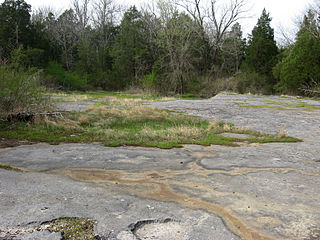
A calcareous glade is a type of ecological community that is found in the central Eastern United States. Calcareous glades occur where bedrock such as limestone occurs near or at the surface, and have very shallow and little soil development. Due to the shallow soil and the extreme conditions created by it, trees are often unable to grow in the glades. This creates a habitat that is usually sunny, dry, and hot. Calcareous glade vegetation is more similar to that of a desert habitat than a grassland, being dominated by small spring annuals with occasional geophytic or succulent perennials.

Echinacea tennesseensis, also known as the Tennessee coneflower or Tennessee purple coneflower, is a flowering plant in the family Asteraceae, endemic to the cedar glades of the central portion of the U.S. state of Tennessee.

Astragalus bibullatus, the limestone glade milkvetch or Pyne's ground plum, is an endangered species of flowering plant that is endemic to the cedar glades of the central basin of Tennessee in the United States. It is found in only eight populations located within a few kilometers of each other in Rutherford County, Tennessee.

Eriogonum longifolium var. harperi, also known as Harper's buckwheat or Harper's umbrella plant, is a dicot of the family Polygonaceae, found in areas of nutrient-poor shale soils in Alabama, Kentucky and Tennessee. It lives inconspicuously in an immature vegetative stage for four or more years before developing a flowering stalk, then flowers and dies. It is listed as an endangered species by the state of Tennessee. It has eleven small populations in Alabama and five in Tennessee but its survival in Kentucky is uncertain. According to a leading expert, Professor James L. Reveal of the University of Maryland, its Kentucky population has been reportedly extirpated. Its 2006 Alabama Natural Heritage Program ranking was G4T2S1, demonstrating an opinion that it was "critically imperiled" in that state.
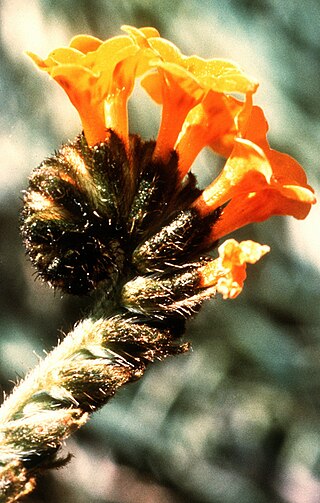
Amsinckia grandiflora is a species of fiddleneck known by the common name large-flowered fiddleneck. This is a wildflower endemic to California and considered a Critically endangered species on the state and national level. Amsinckia grandiflora is one of four 1248 rare heterostylous species within the genus Amsinckia that have highly restricted distributions from which the more weedy homostylous congeners are thought to have evolved.
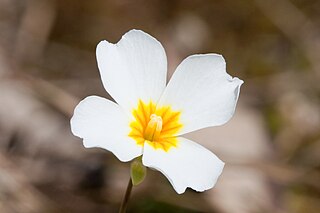
Leavenworthia stylosa is a species of flowering plant in the family Brassicaceae known by the common names cedar gladecress or long-styled gladecress. It is found only in the Central Basin of Tennessee, where it grows in cedar glades, ditches, and low-lying fields. It is an annual herb growing up to 3 in (7.6 cm) tall.
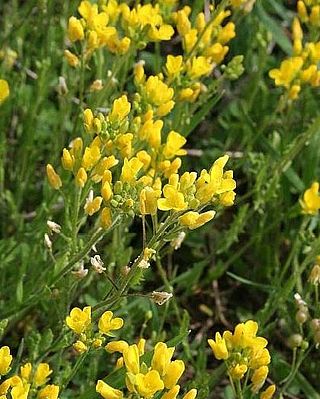
Paysonia lyrata is a rare species of flowering plant in the family Brassicaceae known by the common name lyreleaf bladderpod. It is endemic to Alabama in the United States, where it is known from only three occurrences. It is federally listed as a threatened species.

Physaria filiformis is a rare species of flowering plant in the family Brassicaceae known by the common names Missouri bladderpod and limestone glade bladderpod. It is native to Missouri and Arkansas in the United States. It was federally listed as an endangered species in 1987 and it was downlisted to threatened status in 2003. P. filiformis remains listed as an endangered species at the state level in Missouri.
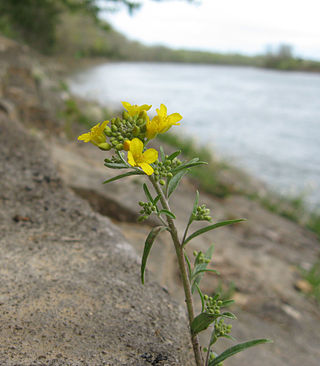
Physaria globosa is a rare flowering plant in the mustard family commonly known as globe bladderpod, Short's bladderpod, and Lesquereux's mustard. It is endemic to the United States, where it is limited to Indiana, Kentucky, and Tennessee. It is a rare species throughout its range and in 2014 the U.S. Fish and Wildlife Service issued a final rule protecting it under the Endangered Species Act.

Leavenworthia is a genus of flowering plants in the family Brassicaceae. It includes about eight species native to the southern and southeastern United States. They are known generally as gladecresses.
Leavenworthia crassa is a species of flowering plant in the mustard family, Brassicaceae, known commonly as the fleshy-fruit gladecress. It is endemic to Alabama in the United States, where it occurs in only two counties. It is "likely one of the most imperiled plant species in the Southeast," and the United States Fish and Wildlife Service issued a final rule listing it as an endangered species in 2014.

Clinopodium glabellum is a species of flowering plant in the mint family. It is commonly known as glade calamint, glade savory, and glade wild basil. It is native to the Nashville Basin of Tennessee, the Bluegrass Region of Kentucky, and two counties in Alabama. Within this range, it is found only on wet cedar glades and in seeps along limestone creekbeds. Due to its narrow range and specific habitat requirements, this species is considered vulnerable.

Bradburia pilosa, the soft goldenaster, is a North American species of flowering plants in the family Asteraceae, native to the south-central United States, primarily the southeastern Great Plains and lower Mississippi Valley, in the states of Texas, Oklahoma, Kansas, Missouri, Arkansas, Louisiana, Tennessee, Mississippi, and Alabama. Additional populations are reported farther east but these appear to be introductions. Its habitats include disturbed roadsides and pine-oak-juniper woods.

Leavenworthia torulosa, the necklace gladecress, is a species of plant in the mustard family. It is native to the eastern United States where it is only found near limestone cedar glades of Alabama, Georgia, Kentucky, and Tennessee. It is considered rare in all states it is found except Tennessee, where it is common in the Nashville Basin due to the abundance of available habitat.

Boechera patens, commonly called spreading rockcress, is a species of flowering plant in the mustard family (Brassicaceae). It is a short-lived biennial forb native to North America. Its natural habitat is xeric soil, often on calcareous substrates. It produces white flowers in the spring.
Leavenworthia exigua var. laciniata, the Kentucky glade cress, is a threatened variety of flowering annual plant in the mustard family endemic to a small area in the southern outskirts of Louisville, Kentucky. The taxon is listed as threatened by the U.S. Fish and Wildlife Service. The federal government designated 2,053 acres as critical habitat for Kentucky glade cress. Critical habitat for the species in Kentucky's Bullitt and Jefferson counties is threatened by developers, including a proposed natural gas pipeline from Louisville Gas & Electric. A campaign to protect the Kentucky glade cress exists.
















